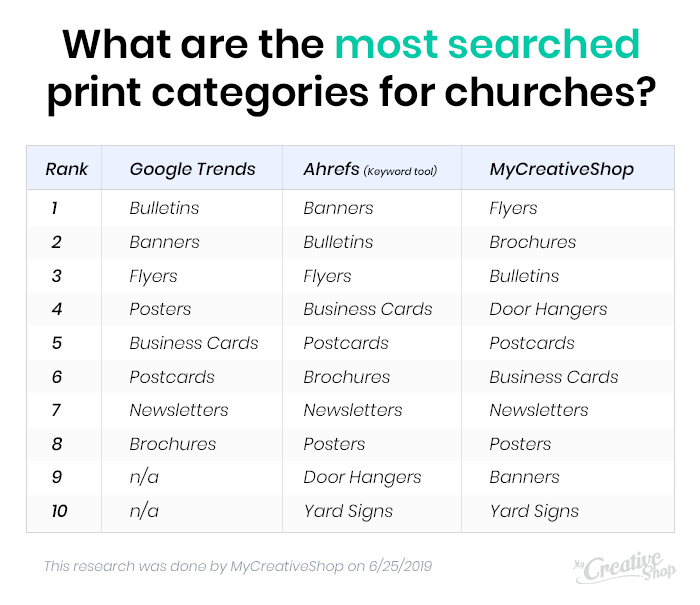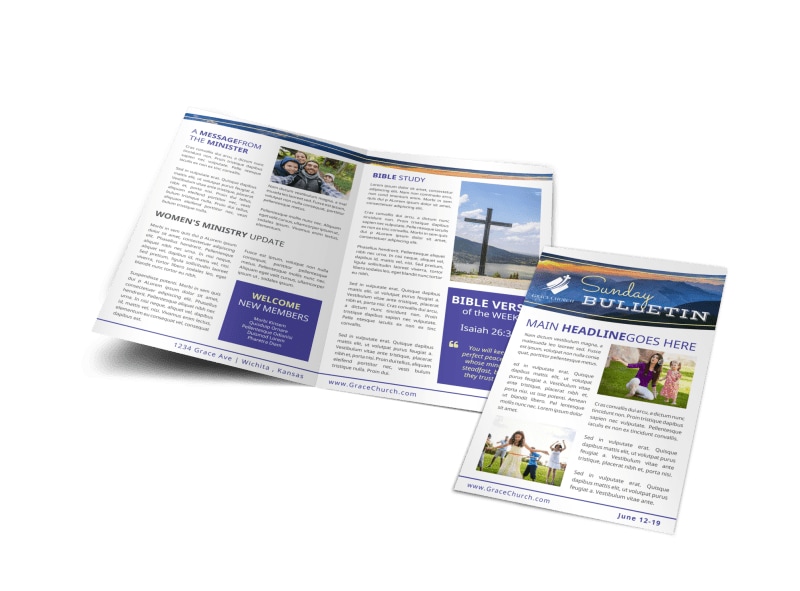How to Develop a Church Marketing Plan for Print


Your church marketing plan provides direction for how you ll grow your congregation and print allows you to meet those potential parishioners where they are, whether they re in your church or opening the mail at home.
As such, print is critical for driving community awareness, but without a roadmap, you re left making guesses and scrambling to find the budget you need to execute. Use this guide to reach your local community with a clear church marketing plan that leverages print as the primary marketing method.
Get to Know Your Community and Church Members

It s important to know who lives in your community so you can better target the right people with your church marketing plan. But don t rely on your personal knowledge of the community alone. Instead, use the resources available to better understand the demographics of your community.
Start with publicly available data from the U.S. Census Bureau. For example, the Quick Facts for Burlington, Vermont reveals that 12 percent of people younger than 18 years of age, more than 1,500 veterans live here, and more than 16,000 homes are family households.
Round this out by learning about your current community with surveys. Ask parishioners to share about who they are, what they do, how large their families are, and more. You can use tools like Google Surveys and SurveyMonkey to host your survey for free.
Use the survey data to develop parishioner personas user profiles of what the average member of your church looks like. This, combined with the city data, can help you better understand how many potential new members you can reach based on who lives in your community along with the type of person you re targeting.
Consider All Your Print Needs
After mapping out your audience, it s time to find the best way to: target your prospects, keep current members active and involved, and encourage members to promote the church for you. Here are some ways to address these three needs within your church marketing plan:
Target New Members
There are a number of effective methods for reaching potential congregation members based on your new personas. Get started with these examples.
- Flyers: Hang these in high-traffic areas like post offices, gyms, and coffee shops. Use them to reach the younger demographic, who may frequent places where flyers are commonly hung, like coffee shops.
- Direct mail postcards: Send these to prospective members during specific holidays or times of year as a seasonal campaign. Don t forget to include important information like times of worship, the URL of your website, and mission statement. Direct mail, combined with a tool like EDDM, can be used to reach new families.
- Banners: Use these to promote your church to anyone walking or driving by. Remember, your banners need to appeal to a broad audience, so focus more on your church s brand and mission than trying to appeal to a specific type of member.
Church print data research [Our Findings]
By using Google Trends, Ahrefs and our MyCreativeShop data we were able to determine the most searched print categories for churches. Here are the results organized by data source:

Keep Current Members Involved
Remember that it s important to have quality printed materials available during the service and within the church to keep parishioners coming back. This also helps new members better understand your community.
Worship bulletins are one of the best ways for members and visitors to get a glimpse of what s happening at your church. Ahmad Moore says, Even in our digital age, printed bulletins or orders of worship still have an important role to play. Yes, it s possible to send all the information out electronically, but you won t reach the entire Sunday morning crowd that way quite yet. The presence and portability of a printed worship guide still wins for most people.

Bulletins should at least include information about the service, upcoming church events, contact information, and donation instructions. Don t forget to hand out newsletters, as well, which help keep everyone involved and engaged with the church community.
Encourage Member Promotion
According to LifeWay Research, more than 30 percent of people who stopped attending church for at least one year as a young adult returned to attending services. They came back with encouragement from family (37 percent) and friends (19 percent). This is where referral cards can be used as a valuable tool. Members can hand these out to family and friends, helping you to expand the church community, one referral at a time.
Finally, as you choose the best print assets for your needs, consider what other churches are finding most helpful right now as well:
Determine the Total Costs and Budgeting
Line up the important print assets you've identified with the holidays, events and seasons when they ll be used. For example, you may want to send a holiday postcard campaign to local families, encouraging them to attend your Christmas Eve celebration.

A marketing calendar allows you to estimate overall print marketing spend and then plan ahead for those expenses as necessary. Here are a few steps to determine your potential costs:
- Add all the events, holidays and seasonal trends into a spreadsheet or document along with the assets needed. I.E. brochures, postcards, flyers, and banners. Use our print marketing calendar guide to help you create this initial outline of your marketing needs.
- Estimate costs for printing and designing your assets using our print to design guide. You can also better understand potential costs by referring to our design pricing use our templates to create your designs! and print cost estimator.
- Benchmark your totals against other non-profits to see where you ve landed. Prosper Strategies 2018 Non-Profit Marketing and Brand Barometer Study found that 5.1 percent to 10 percent of total budget. The average amount spent for top performing non-profits, with 0 percent to 2 percent for average performers.
Finalize Your Church Marketing Plan
Use this as a guide, and allow for flexibility. This is just a guide to help you plan for costs throughout the year. You should be regularly testing new ideas, tracking performance, and making changes to optimize your strategy. Remember that your congregation won t grow overnight. Creating a plan allows you to move toward your goals with intention, ultimately making your efforts more successful.

Read this next: The Print Guide to Marketing for Churches